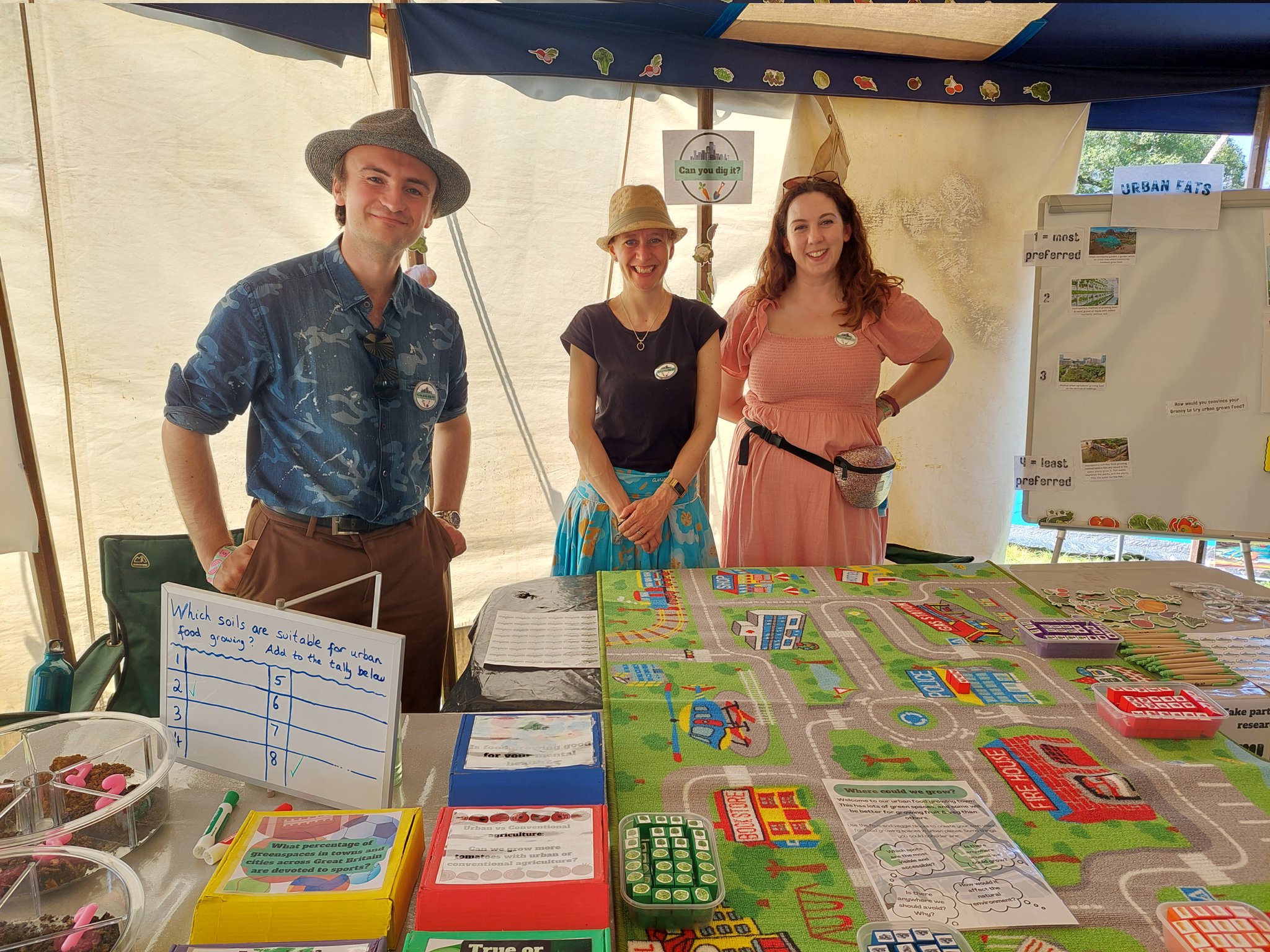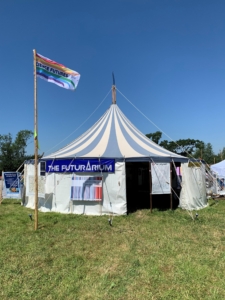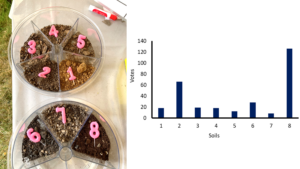‘Can You Dig It?’ at Glastonbury 2022
05/07/2022

From peas in the playing fields to celery from the cemetery – our towns and cities have lots of spaces which we could use to grow food. But what would urban farming do for our health? Could it really help put food on the table? What would it do to our environment?
Rurban Revolution, a two-year Global Food Security programme-funded project has just officially concluded with a residency at Glastonbury 2022. Celebrating the diverse science needed to understand how we can more fairly and sustainably meet our food needs, the Rurban Revolution team created a public engagement space at the popular festival designed to share knowledge about urban food growing through a range of interactive activities. We caught up with Dr Dan Evans of the Cranfield Soil and Agrifood Institute on their return.
Why Glastonbury?

We received an invitation from the Glastonbury Science Futures team. This is a brand-new area within the established ‘Green Futures’ field at the Festival, where festival goers can take a breather from the music, and explore how science shapes our daily lives.
A music festival is, perhaps, an odd choice of location for scientists to talk about and demonstrate their research. I confess to musing on this point too, when I was standing there at the beginning of the week, in a relatively nondescript corner of an under-facilitated field, beside a marquee emblazoned with the words ‘Glastonbury Futurarium’. Very few facets, if any, of a scientist’s daily environment were able to accompany us to the Festival. Stripped bare of the white coats; sterilised work surfaces; ultramodern machines; nests of wires; and all the other bells and whistles that our daily workspaces often entail, we were solely provided a couple of tables, and whatever we could pack into a couple of camping bags.
Our tickets may have been labelled ‘Artists and Performers’, but it was initially difficult to conceive of us performing anything substantive in such a divested space. Of course, I came to realise – as I think all Futurarium ‘performers’ did – that you don’t need flashing neon lights, high-pitched beeps or complex, capacious machines to inspire people about the wonders of science, or to inform them about the findings of your research. All you need is an approachable demeanour, a well-rehearsed and engaging storyboard of your research, and a passion to share your enthusiasm with as many people as possible. Deliver this, and you’ll be richly reimbursed with openminded questions, unfailing curiosity, and a hunger to find out more. I quickly learnt that a music festival represents one of the most effective venues for knowledge exchange. After all, what is a music festival if not a melting pot for ideas, for creative thinking, and for engaging with new perspectives and dimensions?
How did people engage with the stall?
We had a number of activities on offer:

- Urban soils – we exhibited eight soils extracted from within 1 sq. mile of each other in a UK city. We asked visitors to the stand to vote for which soil(s) they considered as most suitable for urban food growing. Although we didn’t initially tell them the precise provenance of the soils, they were all visibly different in colour and texture.
- Planting Fruit and Veg on our Rurban Town – our research has shown that if we used all the green spaces in our UK towns and cities, we could increase domestic food production by eight times. However, we might not want to use all our green spaces, as that would involve us digging up areas such as parks and cemeteries. Instead, we should think strategically about where we plant in urban spaces in the future. We brought along our ‘Rurban Town’ – a table-top mat depicting a town with typical features such as a school, a hospital, a hotel, a railway station, a car park, some green space, an urban farm, and so on. We asked visitors to the stand to explore the map and identify where they would grow fruit and vegetables in the future, placing little wooden fruit/veg counters in the locations of their choosing. At the end of the each day, the map was covered in multi-coloured counters. Some had selected more traditional locations, such as green space and parks, while others had opted to grow fruit and vegetables on the rooftops of buildings, on car parks, and even on the roundabout!
- Ecosystem Services ‘Top Trump’ cards – some of our recent research has demonstrated that urban agriculture doesn’t just have the capacity to put food on a plate; it can deliver a wider range of benefits and functions for both people and planet, too! We call these ‘ecosystem services’ and these can include benefits such as supporting pollination, maintaining air quality, sequestering carbon into the soil, maintaining genetic diversity, supporting mental and physical health, and so on. Visitors to the stand were able to engage with some of these through playing the famous ‘Top Trumps’ game. Eight urban food growing spaces were scored in terms of their ability to deliver nine ecosystem services, and for each space, players had to select the service they thought was best-served. If their card’s score for that service was greater than their partner’s, they won their partner’s card!
- Live study: We also ran a live study at the stand too in which visitors learned about different methods of urban food growing, from more traditional activities such as growing food in gardens, through to high-tech hydroponics and aquaponics. Throughout the week, we captured opinions about foods grown via these different methods. The data will contribute to our ongoing research on consumer perceptions of urban-grown food.
What’s next for Rurban Revolution?
Rurban Revolution has officially concluded, however, many members of the team have follow-up projects. Cranfield University is currently leading a couple of STFC-funded projects which are exploring the potential of vacant and under-utilised spaces for food growing. One of these is based in Newcastle, where we plan to make use of the city’s Urban Observatory network of sensors to help us measure some of the environmental conditions of different vacant spaces in and around the city. We are also working with the London Borough of Islington and the Borough-wide food growing ‘Octopus Communities’ on a project called Urban Cultivate, which seeks to identify a cluster of under-utilised spaces for a wide range of food growing supply chain functions, including food waste collection, soil formation, seedling development, cultivation, food vending, and knowledge exchange.
Categories & Tags:
Leave a comment on this post:
You might also like…
Preparing your work for Turnitin submission
Before submitting your work into Turnitin for similarity checking, if you have used referencing software then you may need to take some important steps first. Mendeley and Zotero integrate with MS Word by embedding field ...
The fast track to supercar engineering: My Cranfield journey
It’s been a dream come true to work on some of the world’s most prestigious supercars – the Aston Martin Valhalla, McLaren 750 & Artura, the GMA T.33. But every successful ...
Automotive Engineering: From student to hypercar innovation at Rimac
We sat down with recent graduate Thomas Perrin, to discuss how his year on the MSc in Automotive Engineering at Cranfield University propelled him from the lecture hall directly into the ...
What this year at Cranfield really meant to me
Every Cranfield journey is unique. In this alumni reflection, Zachea Scicluna shares what her year at Cranfield truly meant, from facing uncertainty to gaining hands-on experience in industry-backed projects. I’ve been reflecting (and delaying) ...
Preparing for assignments and exams?
Sorry! We know it seems a bit mean to mention the exams in January rather than looking forward to the break before it! However, we know many of you will be thinking about your forthcoming ...
Screening for FTSE 100 companies on Bloomberg
So you’re researching an index and need some data on its constituent companies? Bloomberg’s Equity Screening tool makes light work of this, not just for the FTSE, but for indices, exchanges and sectors worldwide. Type EQS ...







